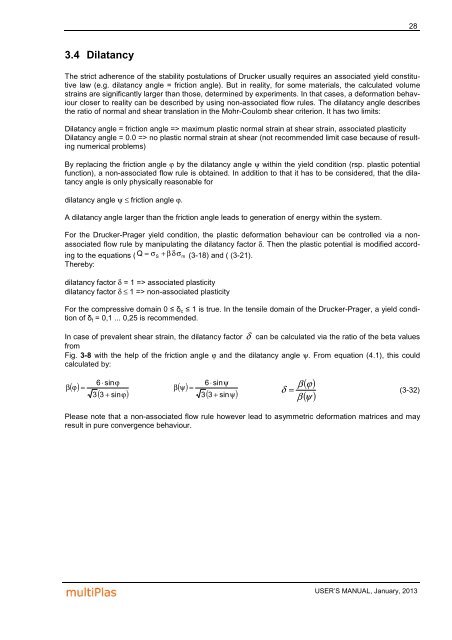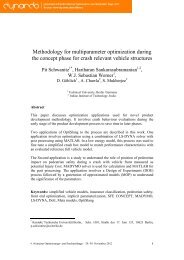multiPlas - Dynardo GmbH
multiPlas - Dynardo GmbH
multiPlas - Dynardo GmbH
Create successful ePaper yourself
Turn your PDF publications into a flip-book with our unique Google optimized e-Paper software.
3.4 Dilatancy<br />
The strict adherence of the stability postulations of Drucker usually requires an associated yield constitutive<br />
law (e.g. dilatancy angle = friction angle). But in reality, for some materials, the calculated volume<br />
strains are significantly larger than those, determined by experiments. In that cases, a deformation behaviour<br />
closer to reality can be described by using non-associated flow rules. The dilatancy angle describes<br />
the ratio of normal and shear translation in the Mohr-Coulomb shear criterion. It has two limits:<br />
Dilatancy angle = friction angle => maximum plastic normal strain at shear strain, associated plasticity<br />
Dilatancy angle = 0.0 => no plastic normal strain at shear (not recommended limit case because of resulting<br />
numerical problems)<br />
By replacing the friction angle ϕ by the dilatancy angle ψ within the yield condition (rsp. plastic potential<br />
function), a non-associated flow rule is obtained. In addition to that it has to be considered, that the dilatancy<br />
angle is only physically reasonable for<br />
dilatancy angle ψ ≤ friction angle ϕ.<br />
A dilatancy angle larger than the friction angle leads to generation of energy within the system.<br />
For the Drucker-Prager yield condition, the plastic deformation behaviour can be controlled via a nonassociated<br />
flow rule by manipulating the dilatancy factor δ. Then the plastic potential is modified according<br />
to the equations ( Q = σS<br />
+ β δσ<br />
m (3-18) and ( (3-21).<br />
Thereby:<br />
dilatancy factor δ = 1 => associated plasticity<br />
dilatancy factor δ ≤ 1 => non-associated plasticity<br />
For the compressive domain 0 ≤ δc ≤ 1 is true. In the tensile domain of the Drucker-Prager, a yield condition<br />
of δt = 0,1 ... 0,25 is recommended.<br />
In case of prevalent shear strain, the dilatancy factor δ can be calculated via the ratio of the beta values<br />
from<br />
Fig. 3-8 with the help of the friction angle ϕ and the dilatancy angle ψ. From equation (4.1), this could<br />
calculated by:<br />
β<br />
( ϕ)<br />
=<br />
3<br />
6 ⋅ sinϕ<br />
( 3 + sinϕ)<br />
β<br />
( ψ)<br />
=<br />
3<br />
6 ⋅ sinψ<br />
( 3 + sinψ)<br />
β<br />
β<br />
( ϕ)<br />
( ψ )<br />
28<br />
δ = (3-32)<br />
Please note that a non-associated flow rule however lead to asymmetric deformation matrices and may<br />
result in pure convergence behaviour.<br />
USER’S MANUAL, January, 2013






